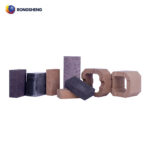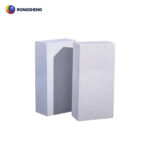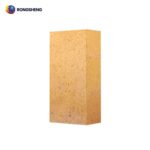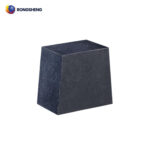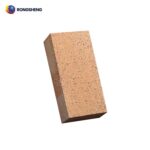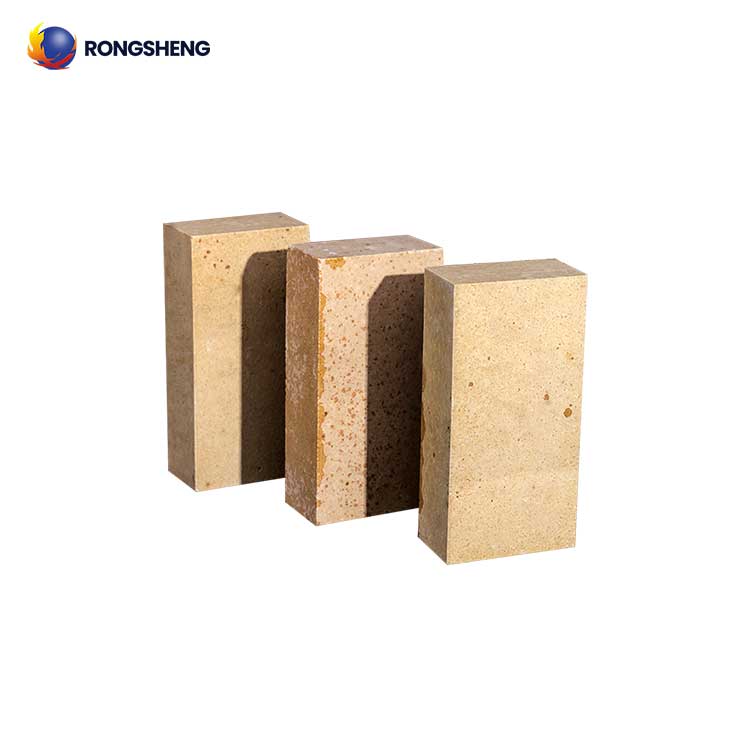
Silica Bricks
- Acidic refractory materials.
- strong resistance to corrosion by acidic slag.
- strong resistance to corrosion by acidic melt.
- The load softening temperature is 1640~1680℃.
- High-quality silica bricks True density < 2.35 g/cm3.
We are Here to Help!
Email: sales@hy-refractory.com
WhatsApp: +86 185 3831 2977
Silica bricks refer to refractory brick products with a SiO2 content of more than 93%. Silica bricks are aluminum-silicon refractory bricks, which are acidic refractory materials and have strong resistance to corrosion by acidic slag or acidic molten liquid. The high load softening temperature is an excellent characteristic of silica bricks, generally 1640~1680℃. Rongsheng Refractory Material Factory supplies high-quality silica bricks, including silica bricks for coke ovens, silica bricks for hot blast furnaces, silica bricks for electric furnaces, silica bricks for glass kilns, etc. Contact Rongsheng for free samples and quotes.
Production Process of Silica Bricks
Silica bricks are made of silica with a SiO2 content of not less than 96%. Mineralizers (such as iron scale, and lime milk) and binders (such as sulfite pulp waste liquid) are added, and the product is made through mixing, molding, drying, and firing. The higher the SiO2 content in the silica raw material, the higher the refractoriness of the product. Impurities such as K2O and Na2O are harmful and will seriously reduce the refractoriness of refractory products. Impurities such as Fe2O3, CaO, and MgO act as fluxes. The raw materials of high-grade silica bricks need to be specially treated to remove impurities.
In the production process of silica bricks, it is appropriate to use a variety of ingredients and multi-level ingredients. To alleviate the harm caused by volume expansion during the firing of the product. Thereby ensuring the reasonable stacking density of the mud and further improving the volume density of the brick.
In order to make silica bricks have a higher compressive strength, mechanical molding should be used as much as possible, except for bricks with special shapes and a small number of production blocks.
Chemical Composition of Silica Bricks
| Chemical Composition of Silica Bricks (w/%) | |||||
| Chemical Composition | SiO2 | Al2O3 | Fe2O3 | CaO | R2O |
| 90 ~ 98 | 0.5 ~ 2.5 | 0.3 ~ 2.5 | 0.2 ~ 2.7 | 1 ~ 1.5 | |
Mineral Composition of Silica Bricks
The mineral composition of silica bricks is a complex phase structure of tridymite, cristobalite, a small amount of residual quartz and glass formed at high temperature. Depending on the production process of silica bricks and the properties of the raw materials used, the mineral composition fluctuates greatly.
| Mineral Composition of Silica Bricks (w/%) | ||||
| Mineral Composition | Tridymite | Cristobalite | Quartz | Glass Phase |
| 30 ~ 70 | 20 ~ 60 | 3 ~ 5 | 4 ~ 40 | |
Technical Indicators of Silica Bricks
Rongsheng’s silica bricks are divided into three grades according to physical and chemical indicators: GZ-94, GZ-95, and GZ-96. The product standard adopted is GB/T2068-2001. The physical and chemical indicators and dimensional tolerances of silica bricks are shown in the table below.
Physical and Chemical Indicators of Silica Bricks
| Physical and Chemical Indicators of Silica Bricks | ||||
| Items | GZ-96 | GZ-95 | GZ-94 | |
| SiO2 % | ≥96 | ≥95 | ≥94 | |
| Fe2O3 % | ≤1.0 | ≤1.2 | ≤1.4 | |
| 0.2MPa Load Softening Start Temperature ℃ | ≥1660 | ≥1650 | ≥1640 | |
| Apparent Porosity % | ≤22(24) | |||
| Compressive Strength at Normal Temperature MPa | Unit Weight < 20kg | ≥35(30) | ||
| Unit Weight ≥ 20kg | ≥30(25) | |||
| True Density g/cm3 | ≤2.34 | ≤2.35 | ||
| Note: The data in brackets are indicators for hand-formed bricks. | ||||
Allowable Deviation of Silica Brick Size (mm)
| Allowable Deviation of Silica Brick Size (mm) | |||||
| Items | Unit Weight < 20kg | Unit Weight 20 ~ 30kg | Unit Weight > 30kg | ||
| Allowable Deviation | Size ≤ 100 | ±1.5 | ±2 | ||
| Size 101 ~ 350 | ±2.5 | ±3 | |||
| Size > 350 | ±3.5 | ±4 | |||
| Distortion | Length ≤ 300 | ≤1.5 | ≤2.0 | ||
| Length > 300 | ≤2.54 | ≤3.0 | |||
| Relative Edge Difference Thickness | ≤1.0 | ≤1.5 | |||
| Length of Missing Corners and Edges
(a+b+c) |
Working surface | ≤35 | ≤35 | ||
| Non-working surface | ≤50 | ≤60 | |||
| Melt Hole Diameter | Working surface | ≤4 | ≤6 | ||
| Non-working surface | ≤6 | ≤8 | |||
| Crack Length | Width ≤0.1 | no limit | no limit | no limit | |
| Width 0.11 ~ 0.25 | Working surface | ≤30 | ≤50 | ≤70 | |
| Non-working surface | ≤50 | ≤80 | ≤100 | ||
| Width 0.26 ~ 0.50 | Working surface | Not allowed | ≤30 | ≤50 | |
| Non-working surface | ≤30 | ≤50 | ≤70 | ||
| Width > 0.50 | Not allowed | ||||
Advantages and Disadvantages of Silica Bricks
Silica bricks are acidic refractory materials with strong resistance to acidic slag or acidic molten liquid corrosion. However, silica bricks have poor resistance to alkaline corrosion and are easily destroyed by oxides such as Al2O3, K2O, and Na2O. They have good resistance to oxides such as CaO, FeO, and Fe2O3.
The high load softening temperature is an excellent characteristic of silica bricks, generally 1640~1680℃. It is close to the melting point of tridymite (1670℃) and the melting point of cristobalite (1713℃).
The volume of silica bricks is stable in the range of above 300℃ to close to the melting point (tridymite or cristobalite). When heated to 1450℃ during use, a volume expansion of about 1.5%~2.2% is generated, which is conducive to ensuring the structural strength and airtightness of the masonry.
The biggest disadvantage of silica bricks is poor thermal shock resistance, and the number of water cooling cycles is generally 1~4 times. Secondly, the refractoriness is not high, generally 1690~1730℃. Therefore, its application range is greatly limited.
True Density Index of Silica Bricks
The properties and process of silica bricks are closely related to the crystal transformation of SiO2. The true density of silica bricks is one of the important indicators to judge the degree of its crystal transformation. Therefore, true density is an important quality index of silica bricks. It is generally required to be below 2.38 g/cm3. High-quality silica bricks should be below 2.35 g/cm3. Low true density reflects that there are more tridymite and cristobalite in silica bricks and less residual quartz. Therefore, the residual expansion is small and the strength loss during use is also small.
Application of Silica Bricks
Silica bricks are mainly used to build the carbonization chamber, combustion chamber, and partition wall of coke ovens. About 73% of the refractory materials used in a coke oven are silica bricks. Glass tank kiln and kiln roof, and tank wall. High-temperature load-bearing parts of a hot blast furnace. Thermal kilns such as carbon roasting furnaces. In order to improve the production capacity of modern large coke ovens, it is necessary to thin the carbonization chamber, combustion chamber, and partition wall of the coke oven, so it is required to use high-density and high thermal conductivity silica bricks.
There are many varieties of silica bricks, which are divided into: silica bricks for coke ovens, silica bricks for hot blast furnaces, silica bricks for electric furnaces, silica bricks for glass kilns, etc. According to the complexity of the brick type, it is divided into standard bricks, general bricks, special-shaped bricks, and special bricks.
Precautions for Using Silica Bricks
When using silica bricks, the following two points should be noted:
- (1) At low temperatures, the volume of siliceous products changes greatly due to the change in the crystal form of the remaining quartz. Therefore, when baking the furnace, the temperature should not be raised too quickly below 600°C. When cooling to 600°C, it should be cooled slowly to avoid cracks.
- (2) Avoid contact with alkaline slag as much as possible.
With the large-scale coke oven, the carbonization chamber has increased from 4 m to 7 m, and the requirements for the quality and size of the refractory materials used have been further improved. In the future, the production technology of silica bricks should be developed in the direction of increasing its SiO2 content, reducing the impurity content, and especially reducing the Al2O3 content. In terms of performance, the direction is to increase the density and compressive strength of the product and reduce the porosity.

